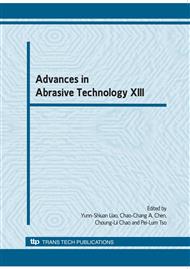p.148
p.154
p.159
p.165
p.171
p.177
p.181
p.189
p.195
Modeling Surface Roughness and Hardness of Grinding SKD11 Steel Using Adaptive Network Based Fuzzy Inference
Abstract:
Grinding is a commonly used process in precision machining. This paper is aimed to establish a model for predicting surface roughness and hardness with respect to grinding parameters, including wheel speed, feed rate and depth of grinding for the SKD11 molding steel. The Adaptive Network based Fuzzy Inference (ANFIS) is used to construct the grinding model that is trained by experimental data from grinding the SKD11 steel. Test experiments are then conducted to verify the model. Results from the test experiments showed that the average error between surface roughness predicted by the model and the measured data is 3.94%. The average different of the hardness between the measured data and that predicted by the model is less than 0.06%. It verifies that the model can be used to predict surface roughness and hardness for different grinding parameters.
Info:
Periodical:
Pages:
171-176
Citation:
Online since:
August 2010
Authors:
Price:
Сopyright:
© 2010 Trans Tech Publications Ltd. All Rights Reserved
Share:
Citation:


